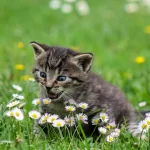When it comes to the Bengal cat family, the Silver Bengal cat is a relatively new addition. They feature a base coat that ranges from white to steel-silver, black, or blue and is highlighted with black and grey patches.
Silver Bengal cats, like other Bengal cats, come in two colors: silver-spotted and silver-marbled. They fascinate viewers with their silvery-stripped coats and their enchanted green or yellow/golden eyes.
There are only a few silver Bengal cats in existence.
Bengals are the result of crossbreeding domestic cats with Asian leopard cats. This breeding aimed to produce a cat with the temperament of a domestic cat and the crazy and wild patterns of the Asian leopard cat.

Silver Bengals were developed in the 1990s as a hybrid breed. They are the offspring of a Bengal and an American shorthair cat hybrid. While most people believe Silver to be a distinct color, specialists consider it to lack color. This is due to the presence of an inhibitory gene.
Silver Bengal cats are scarce. Many people think normal brown Bengal cats are rare. However, silver Bengal cats are a rarer breed than brown Bengal cats. Silver is a very new color scheme in Bengal cats; it was only approved in the breed in 2004.
The rarest Silver Bengal cat will have both Silver’s inhibitor genes.
Silver Bengal cats, like several other Bengal cat families, are easygoing. They enjoy expressing their love for their loyal parents.
They are highly active cats who enjoy playing. They dislike long periods of inactivity. They are exceptional climbers and would like to climb on bookcases and doors, among other things, in the house. Be prepared for them to knock things over and break things. They will regard your home like a jungle.
If you want to ensure that your Silver Bengal cat does not destroy anything, you can get a cat window perch, cat hammocks, or a cat tree for her. These should be arranged to allow your cat to move between them.
When it comes to the size of silver Bengal cats, they are the same as any other Bengal.
Male Bengals weigh between 10-15lbs (4.5-6.8kg), whereas female Bengals weigh between 6-10lbs (2.7-4.5kg). Therefore, the larger Bengals might weigh 22lbs (10kg).
Bengals, on the other hand, are not among those breeds. Therefore, Bengal cats need to be with either a human or another animal.
A smart Bengal cat will communicate effectively with you about its requirements. They are the noisiest and most communicative cat breed. Persistent demands are also a feature of their personality.
This type of cat will annoy you until it has what it demands, whether it be a source of nutrition, water, toys, or attention.
The Bengal is a common species due to its jungle habitat. Therefore, daily meals, walks, fun activities, and other scheduled activities must co-occur.
To some extent, all cats hunt. It is part of their nature. However, some hunters are more skilled than others, and some are more motivated to pursue than others. Due to its breeding, the Bengal is motivated to hunt.
The Bengal cat’s appearance, size, and temperament may cause some people to feel scared. This is a popular misconception about the Bengal cat. Bengals are not more aggressive than other cats. Those who are not adequately socialized, on the other hand, tend to have a wild side.

Silver Bengals are more expensive than regular Bengals due to their rarity. While an adult or mature Silver Bengal cat can be purchased for a few hundred dollars, a Silver Bengal kitten can be bought for three thousand dollars.
The majority of Bengals are priced between $1,400 and $3,000. They start at $3,000 and go as high as $5,000 or more. However, it’s also true that some breeders charge more.
Breeder rights are required for those who wish to breed cats. So, these can cost thousands of dollars more.
Silver Bengals are known as hypoallergenic cats because of their short hair and low to non-existent shedding. As a result, the Silver Bengal cat is suitable for allergy sufferers.
Silver Bengal cats, unlike other Bengal cats, do not require grooming. Once a week, you can brush their coat to keep it healthy and shimmery. However, brushing more frequently would strengthen your relationship with your pet.
Bengals are a way to discover genetics. Breeders must genetically test pairings and kittens to acquire the appropriate colors, markings, and health.
Breeders select specific Bengals for breeding to obtain particular results. In addition, cats must be fed a special diet of organic and raw foods and kept in specific catteries. Taking everything into consideration, the pricing is relatively high.
Bengal cats are available in several colors and shades and have various markings. Silver Bengals were recognized as a TICA championship variety in 2004, making them an excellent choice if you’re looking for a champ based on their pedigree.
Silver Bengals have a fabulous coat with minimal warm colors. Small pieces of yellow or brown can occasionally be found, particularly around the face and legs, but the best ones have very little of this.
Gray and black marks contrast against a light gray or nearly white background.
The melanistic Silver Bengal is one of the more popular and intriguing Silver Bengal breeds. It is one color, but there are different variations of Silver in the markings. The Smoke Bengal cat is a silver cat with a silver background and silver markings.
Have you just gotten a Silver Bengal? Or you’re ready to buy a Silver Bengal and aren’t sure if it’s a silver Bengal. Here are a few things to look out for when determining if your cat is a Silver Bengal.

- Spotting or marbling ranging from grey to jet black
- Tail with a black tip
- A nose that is brick-red in color
- Green, yellow, or gold eyes
- It may be slightly tarnished
There are Bengal breeders in the US, Canada, and worldwide. However, they are less common than other carriers. Even so, Bengal cats are among the rare cat breeds worldwide.
When searching for and interviewing Bengal breeders, the following is a list of items to keep in mind:
- Reputable breeders will inform you or show you their facilities. Catteries should be constructed structures with heating and cooling appropriately. The cats and kittens should be allowed to roam freely in non-caged areas most of the time.
- Some Bengal breeders specialize in specific breed variations, such as Silver or Snow Bengals. Some others will have a wide range of colors and patterns.
- Inquire about the care of queens and kittens. Some breeders choose to keep their animals in specially built areas and even their homes.
- When a kitten is less than 11 weeks, a good breeder will not release it; however, most will not remove it until the cat is 12 and 14 weeks old.
- Verify that they are still in good condition with TIPA and other cat organizations. Additionally, inquire whether their program has any champion cats or if they have received any awards.
- The cattery owner should be available to answer any queries you may have even after you’ve brought the kitten home. New cat owners may have particular difficulties as their kittens mature.
Their most distinguishing characteristic is their beautiful coat. A Bengal is usually associated with sports; however, they also have marble and rosette coats.
Rosetting is what gives certain people spots that resemble doughnuts rather than dots. Rosetting consists of areas with two distinct colors. Marbling is a type of horizontal striping that creates a beautiful array of shimmies and swirls on the body’s side and back.
Cinnamon bun-like swirls are standard when depicting a cat, yet they are stunning.
Silver Bengals can be pretty stunning. The introduction of genes that decrease the characteristic brown coloration resulted in this appealing, ‘wintery’ looking cat.
Because the silver inhibitory gene is handed down regardless of color, silver variations of snow, blues, black, and melanistic have also been developed, adding to the breed’s diversity.
Because of their recent creation, however, they are rare than brown Bengals and, as a result, are potentially more expensive.
Silver Bengals are unique in appearance but share all other Bengal cat characteristics, including size, temperament, and lifespan.
Several variables might affect the price of a Silver Bengal, so it’s important to know what they are before selecting.




